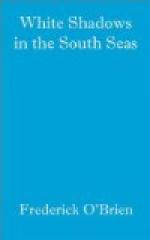A young dog was also part of the fare, and was cooked in the same manner as the pig. The Marquesans are fond of dogs. This particular one had been brought to this valley from another and was not on friendly terms with any of his butchers. In fact, his death was due more to revenge than to hunger for his flesh. He had bitten the leg of a man who lived in the upper part of Oomoa, and when this man came limping to the banquet, he brought the biter as his contribution.
Those who would turn up their noses at Towser must hear Captain Cook, who was himself slain and dismembered in Hawaii:
“The flesh of the South Sea Dog is a meat not to be despised. It is next to our English Lamb.”
Personally I am willing to let it be next to lamb at every meal, and I shall always take its neighbor, but it argues a narrow taste not to concede that the dishes of our foreign friends may have a relish all their own. Dog has been a Maori tidbit for thousands of years. It was introduced into New Zealand from these islands. The aborigines had a fierce, undomesticated dog, which they hunted for its flesh. It was a sort of fox, but disappeared before the Polynesians reached the islands.
All Polynesians have liked dogs, liked them as pets, as they do to-day, and liked them as grub. If one asks how one can pet Fido Monday and eat him Tuesday, I will reply that we, the highest types of civilization, pet calves and lambs, chickens and rabbits, and find them not a whit the less toothsome. The Marquesan loves his pig as we love our dog, cuddles him, calls him fond names, believes that he goes to heaven,—and nevertheless roasts him for dinner.
The yams, potatoes, breadfruit, and other accompaniments of the dog, pig, and chicken were all ready at six o’clock, when cries of delight summoned us idlers. The earth had been cleared from the oven, the leaves removed, and the pig was lifted into the air, cooked to a turn, succulent, steaming, delicious. The feast was spread in a clearing, so that the sun, sinking slowly in the west, might filter his rays through the lofty trees and leave us brightened by his presence, but cool in the shadows. For me a Roman couch of mats was spread, while the natives squatted in the comfort of men whose legs are natural.
The women waited upon us, passing all the food in leaves, in cleanly fashion. Pae herself, though hostess, could not eat till all the men were satisfied, for the tapu still holds, though without authority. Knives nor forks hindered our free onslaught upon the edibles, and there were cocoanut-shells beside each of us for washing our hands between courses, a usual custom.
Piahi, the native chestnuts shelled and cooked in cocoanut-milk, were an appetizer, followed by small fish, which we ate raw after soaking them in lime juice. There is no dish that the white man so soon learns to crave and so long remembers when departed. Some of the guests did not like the sauce, but took their small fish by the tail, dripping with salt water, and ate it as one might eat celery, bones, and all.




